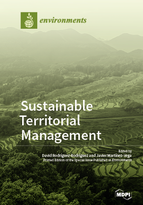Sustainable Territorial Management
A special issue of Environments (ISSN 2076-3298).
Deadline for manuscript submissions: closed (30 September 2017) | Viewed by 94109
Special Issue Editors
2. European Topic Centre-University of Malaga, Calle Arquitecto Francisco Peñalosa s/n, Ampliación Campus Teatinos, 29010 Malaga, Spain
Interests: sustainability indicators; protected area effectiveness evaluation; territorial planning; socioeconomic effects of public policies
Special Issues, Collections and Topics in MDPI journals
Interests: spatial analysis; environment; climate change; sustainability; biodiversity; sustainable agriculture sustainable development
Special Issues, Collections and Topics in MDPI journals
Special Issue Information
Dear Colleagues,
Recent human development has made a notable social and economic progress for most of us possible; however, it has also had a range of negative consequences on natural resources, local communities, and the economy at multiple scales. Soil sealing, erosion and loss, land degradation, air and water pollution, biodiversity homogenisation and loss, poverty, human migration, and health issues are among the most common human-made impacts with a clear sustainability and spatial component. They occur in territories, be it terrestrial, aerial, or marine, which are the physical bases for whichever activity is being performed by any living being. Thus, achieving sustainable territorial management, which combines healthy and prosperous societies with the long-term maintenance of a rich biodiversity and productive ecosystem services, remains the biggest challenge to our modern world. This Special Issue seeks to collect a coherent set of studies on techniques and experiences (case studies) aimed at increasing the environmental, social, economic, and/or institutional sustainability of landscapes and seascapes from a range of geographic and socioeconomic contexts.
Dr. David Rodríguez-Rodríguez
Dr. Javier Martínez-Vega
Guest Editors
Manuscript Submission Information
Manuscripts should be submitted online at www.mdpi.com by registering and logging in to this website. Once you are registered, click here to go to the submission form. Manuscripts can be submitted until the deadline. All submissions that pass pre-check are peer-reviewed. Accepted papers will be published continuously in the journal (as soon as accepted) and will be listed together on the special issue website. Research articles, review articles as well as short communications are invited. For planned papers, a title and short abstract (about 100 words) can be sent to the Editorial Office for announcement on this website.
Submitted manuscripts should not have been published previously, nor be under consideration for publication elsewhere (except conference proceedings papers). All manuscripts are thoroughly refereed through a single-blind peer-review process. A guide for authors and other relevant information for submission of manuscripts is available on the Instructions for Authors page. Environments is an international peer-reviewed open access monthly journal published by MDPI.
Please visit the Instructions for Authors page before submitting a manuscript. The Article Processing Charge (APC) for publication in this open access journal is 1800 CHF (Swiss Francs). Submitted papers should be well formatted and use good English. Authors may use MDPI's English editing service prior to publication or during author revisions.
Keywords
-
Sustainable development
-
Territorial planning
-
Land use-land cover
-
Protected area
-
Biodiversity
-
Maritime planning
-
Integrated coastal zone management
-
Socioeconomy
-
Governance







